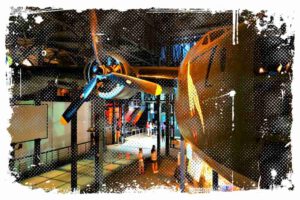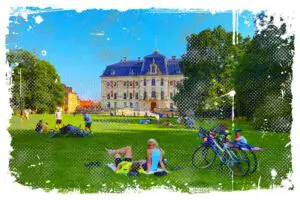Poland is a European country where many of its cities feature a medieval layout and architectural heritage from different eras. These cities combine their rich history and traditions with modern growth and development. Which cities in Poland are the biggest by their area and what makes them worth a visit?

The capital of Poland, Warsaw, is the largest city by area and covers over 517 square kilometers. There are other large cities in Poland, such as Swinoujscie which ranks 9th in terms of area, despite not being among even the top 100 largest cities by population. Szczecin also has a large area, ranking 3rd, and 7th in terms of population.
Ranking of Poland’s Largest Cities by Area
Where does the data on Poland’s largest cities come from? The data comes from the General Statistical Office (GUS). This information goes beyond just the population size, and takes into account the overall area of the cities. The data provided by the Central Statistical Office allowed me to create a ranking of the top 20 largest cities in Poland by area.
| Ranking | City | Area [km2] | Population [Thousands] (2022) |
|---|---|---|---|
| 1 | Warszawa | 517 | 1860 |
| 2 | Kraków | 327 | 800 |
| 3 | Szczecin | 301 | 396 |
| 4 | Wrocław | 293 | 672 |
| 5 | Łódź | 293 | 670 |
| 6 | Zielona Góra | 277 | 140 |
| 7 | Poznań | 262 | 546 |
| 8 | Gdańsk | 262 | 486 |
| 9 | Świnoujście | 202 | 41 |
| 10 | Dąbrowa Górnicza | 189 | 121 |
| 11 | Bydgoszcz | 176 | 354 |
| 12 | Katowice | 165 | 286 |
| 13 | Częstochowa | 160 | 217 |
| 14 | Jaworzno | 152 | 86 |
| 15 | Opole | 149 | 127 |
| 16 | Rybnik | 148 | 135 |
| 17 | Lublin | 147 | 336 |
| 18 | Gdynia | 135 | 244 |
| 19 | Gliwice | 134 | 166 |
| 20 | Rzeszów | 129 | 198 |
1. Warszawa (Warsaw)

Warsaw, the capital and largest city of Poland, tops the ranking in both area and population. It is known for its towering skyscrapers, with 74 buildings over 60 meters high and 25 over 100 meters. Warsaw spans both sides of the Vistula River, and both banks are connected by 10 bridges.
↳ PRO TIP: Do you like traveling? Then before you buy any ticket or book an attraction, check if it's available in this worldwide Viator Database. You may save a lot of money and time. No need to thank me :)
The city is located in the Mazowieckie province, covers an area of 51,724 hectares, and is home to over 1.7 million residents. It is a city that attracts many people looking for work or education opportunities.
2. Kraków (Cracow)

Krakow, located in the Lesser Poland Voivodeship, was the former capital of Poland and now serves as the capital of the province. It covers an area of 32,685 hectares and is home to over 782,000 residents. Here you can find interesting information about Krakow districts.
Krakow is a popular tourist destination, attracting visitors from around the world during peak season. Known for its stunning ancient layout, historic tenement houses, the Cloth Hall, and the Wawel Royal Castle, it is considered one of the most beautiful cities in Poland. By the way – please check my other article I wrote about the official symbols of Krakow.
3. Szczecin

Szczecin, located in the West Pomeranian Voivodeship, is a city renowned for its tall townhouses and an urban layout that has been compared to the charming streets of Paris. With an area of 30,060 hectares and a population of nearly 400,000, Szczecin is a vital economic center in the region, thanks to its prime location on the Baltic Sea and Szczecin Lagoon.
This makes it a popular holiday destination, drawing visitors to its picturesque harbor and iconic landmarks such as the Castle of the Pomeranian Dukes and the Chrobry Embankment, which runs along the river.
4. Łódź (Lodz)
Lodz is a capital of the province, covers an area of almost 30,000 hectares, and is home to more than 660,000 people. A must-see destination in the city is the famous Piotrkowska Street, known for its historic tenement houses and being one of the longest shopping streets in Europe. Visitors can find a wide range of cuisines from all over the world at the various restaurants, in addition to an abundance of stores and cafes.
Lodz was an important center for textile industry in the 19th century during the Great Industrial Revolution. Today, many post-industrial spaces have been transformed into modern cultural or gastronomic complexes. To gain an insight into the city’s history, visitors can check out the Central Textile Museum and the Museum of the City of Lodz.
5. Wrocław (Wroclaw)
Wroclaw is located in the Lower Silesian Voivodship and is considered one of the most picturesque cities in Poland. It has a rich history of being passed between German and Polish hands. Today, it covers an area of nearly 30,000 hectares and is home to over 640,000 residents. A must-see attraction in Wroclaw is the renowned Panorama of Raclawice, a masterpiece co-created by Wojciech Kossak.
6. Zielona Góra (Zielona Gora)
Zielona Gora, located in the Lubuskie province, covers an area slightly over 27,000 hectares and is home to more than 140,000 residents. The area around Zielona Gora boasts a unique folklore, and history and ethnography enthusiasts can visit the local Museum of the Lubuska Land or the Museum of Ethnography. The favorable conditions and locaton make the slopes on the outskirts of the city ideal for grape farming.
7. Gdańsk (Gdansk)
Gdansk, located in the Pomeranian Voivodeship, covers an area of more than 26,000 hectares. Like Wrocław, Gdansk has a history of being claimed by both Germans and Poles. After World War I, the Treaty of Versailles was signed, and the League of Nations was established the following year.
One of its first tasks was to administer the Free City of Gdansk. The city was later incorporated into Poland after World War II, but its multicultural heritage can still be felt today as a result of its complicated history.
8. Poznań (Poznan)
Poznan is a city located in the Greater Poland province, covering an area of more than 26,000 hectares and being home to more than 530,000 people. It is the historical capital of Greater Poland, and a modern city that has won numerous awards for its high-quality city brand.
The city’s most iconic landmarks include the old Market Square, surrounded by historic townhouses, which is the third largest market in Poland and one of the largest in Europe. The Citadel Park in Poznan is a peaceful spot to take a break from the bustling city while admiring historic ruins. Tourists also frequently visit the Imperial Castle and Lake Malta while in Poznan.
9. Świnoujscie (Swinoujscie)
Swinoujscie is a unique city with a large land area compared to its small population. It boasts three beautiful parks and plenty of greenery along the waterfront. The city is situated on three islands, and a vast 106 km2 of its territory is covered by water. It’s located in the West Pomeranian region, known for its spa-like atmosphere.
With an area spanning over 20,000 hectares, it’s situated by the Swina River and the Baltic Sea. Though the population is around 40,000, it swells during the summer as visitors flock to its sandy beaches. Some must-see attractions include the Wolin National Park, the Lighthouse, and the extensive beaches with promenades where you can savor local seaside cuisine.
10. Dąbrowa Górnicza (Dabrawa Gornicza)
Dabrowa Gornicza is a city located in the Silesian province, with a territory slightly larger than 18,000 hectares. It’s the largest city in Silesia and is home to over 118,000 residents. Though it may not be a major tourist destination, there are several noteworthy sites to visit.
One of them is the Rabsztyn Castle. The “Sztygarka” museum is also worth visiting, where you can learn about the history of the Zagłębie region and gain a better understanding of the complex relationship between Dabrowa and Silesia.
References:
- https://pl.wikipedia.org/wiki/Miasta_w_Polsce



